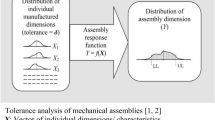Abstract
When calculating the tolerance of an assembly dimension chain with compensation loop, the value calculated by the basic formula for dimension chains must be a negative or imaginary number; this value is referred to as virtual tolerance in this paper. Virtual tolerance is not covered by tolerance theory. However, after reviewing such relevant concepts such as negative and positive numbers, the essence of virtual tolerance can be defined as follows: the absolute value of virtual tolerance (or the imaginary part) is the error compensation amount and the size between the upper and lower deviations is the compensation range. Therefore, the amount and range of error compensation are both added to the scope of tolerance so that they can be described in a digital way; in the meantime, the range of tolerance is extended to any number. Based on the concept of virtual tolerance, the tolerance and the error compensation amount can be calculated synchronously, leading to a simplified analysis and calculation process; computer-aided design is also facilitated. According to probability theory and the relevant concepts of dimension chains, the only correct result is that the error compensation amount is the imaginary part of virtual tolerance. But since the error compensation amount calculated by the probabilistic method does not ensure assembly accuracy, a theoretical basis is provided to calculate the assembly dimension chain with compensation loop by the probabilistic method.
Similar content being viewed by others
References
ZHAO Zexiang (1999) Tolerance Fit and Quality Control [S] Henan University Press:3–8
BKA Ngoi, CT Ong (1996) Optimum assembly using a component dimensioning method [J] The International Journal of Advanced Manufacturing Technology. Volume 11, Issue 3
Peng H (2009) Study on theory and methodology of tolerance design within the framework of the New generation GPS standards system [D]. Huazhong University of Science and Technology, Wuhan
Ping Ji (1994) An automatic tolerance assignment approach for tolerance charting [J] Int J Adv Manuf Technol, Volume 9, Issue 6
Wang T (2005) Application of Monte Carlo method to dimension and tolerance design [J]. Trans Chin Soc Agric Mach 36(5):101–104
Wang Xiankui (2011) Mechanical Manufactuloop Engineeloop Foundation [M] National Defence Industry Press.8:350–357
National Standard of PRC. GB/T 5847–1986: Calculation Methods of Dimensional Chains
Chunfu LI (1986) Calculation of assembly dimension chain and process dimension chain [M]. Shanghai Sci Technol Press 1:39–41
Author information
Authors and Affiliations
Corresponding author
Additional information
This project is supported by the National Natural Science Foundation of China (Grant Number: 51175360).
Rights and permissions
About this article
Cite this article
Wang, X., Sun, C., Yao, Y. et al. Extension of the definition of tolerance and an application thereof in the calculation of dimension chains. Int J Adv Manuf Technol 71, 1069–1076 (2014). https://doi.org/10.1007/s00170-013-5533-5
Received:
Accepted:
Published:
Issue Date:
DOI: https://doi.org/10.1007/s00170-013-5533-5




